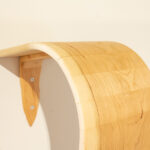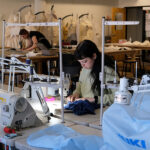 Four Industrial Design students took home awards in two competitions: the national InterZinc Zinc Challenge and the 2013 Association of Rotational Molders’ (ARM) International Student Design Competition.
Four Industrial Design students took home awards in two competitions: the national InterZinc Zinc Challenge and the 2013 Association of Rotational Molders’ (ARM) International Student Design Competition.
The students were all juniors during the submission process and taught by Senior Professor of Industrial Design Pascal Malassigné, FIDSA.
Ross Stalter’14 placed first in the InterZinc Zinc Challenge for his bow caliper design. The challenge called for using zinc to create a measuring tool that uses and highlights the benefits of zinc.
Stalter said he “stumbled upon a bow caliper,” and wanted to make it more functional. “While using it, you have to push down and then pull, and then take another device and measure between two points. It becomes pretty inefficient, so I thought, ‘Why not just integrate a dial readout on it.'”
 Designed using zinc’s ability to be held to tight tolerances and create natural bearing surfaces, Stalter’s caliper is strong, with a very thin wall.
Designed using zinc’s ability to be held to tight tolerances and create natural bearing surfaces, Stalter’s caliper is strong, with a very thin wall.
Stalter’s win marks the fifth time a MIAD student has won this award in the last 10 years, and the second year in a row a MIAD student has placed first.
MIAD students also took top honors at the ARM International Student Design Competition. This competition requires a final product to be rotationally molded, but let the designers choose the consumer and type of product.
Winners:
 Gold – Thibaut Rouganne (internationalstudent, 2013), Nautic. “Nautic is a table bar characterized by a strong scenographic impact due to its refined shapes,” said Rouganne. “The goal was to put elegance and to give life to the plastic material.”
Gold – Thibaut Rouganne (internationalstudent, 2013), Nautic. “Nautic is a table bar characterized by a strong scenographic impact due to its refined shapes,” said Rouganne. “The goal was to put elegance and to give life to the plastic material.” Silver – Zachary Handziak ’14, Block Stool. “The stool’s simple form consists only of a rotomolded body, and a buckle attached cushion. Its distinct shape accounts for ease of part removal in overall draft, as well as stackability. Their modular nature allows them to be placed side-by-side for a bench application, or one on top of the other to form a taller bar stool,” said Handziak.
Silver – Zachary Handziak ’14, Block Stool. “The stool’s simple form consists only of a rotomolded body, and a buckle attached cushion. Its distinct shape accounts for ease of part removal in overall draft, as well as stackability. Their modular nature allows them to be placed side-by-side for a bench application, or one on top of the other to form a taller bar stool,” said Handziak. Bronze – Ryan Frazier ’14, sprouT. “Designed for use by children and adults, sprouT blurs the line between furniture and tool,” said Frazier. “When rotated clockwise, the table lowers 30 centimeters and the chairs expand outward. Rotating counterclockwise, the chairs return to their closed position and re-elevate the tabletop to the average countertop height of 90 centimeters.”
Bronze – Ryan Frazier ’14, sprouT. “Designed for use by children and adults, sprouT blurs the line between furniture and tool,” said Frazier. “When rotated clockwise, the table lowers 30 centimeters and the chairs expand outward. Rotating counterclockwise, the chairs return to their closed position and re-elevate the tabletop to the average countertop height of 90 centimeters.”
Top image: Ross Stalter ’14 (Industrial Design)
Second image: Stalter’s boat caliper design
Third image: Thibaut Rouganne, Nautic
Fourth image: Zachary Handziak, Block Stool
Fifth image: Ryan Frazier, sprouT





